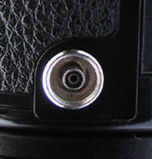System Overview on Canon EOS-1N flash photography
Unlike ambient light photography where various current technologies focused at, taking well exposed pictures is relatively quite an easy process. If you are not very particular with qualitative element, taking acceptable flash pictures can also be easily achievable. However, a step beyond this, advance flash photography can be quite tricky as you are toying around a Speedlite that only emitting a short burst of light to the scene you intend to capture to get a specific result you intend to portray. Like it or not, I think most would agree with me that taking successful flash photography is not as easy as taking pictures in ambient light. However, as long as you treat it as a valuable tool for you to, firstly - overcome certain unfavorable lighting conditions, and a channel to explore some photographic possibilities never tried before in ambient light, why would you afraid of using a flash ? Well, to begin with this, understanding what the camera limitations in this area will often increases in bringing higher rate of successful creatively taken flash photography.
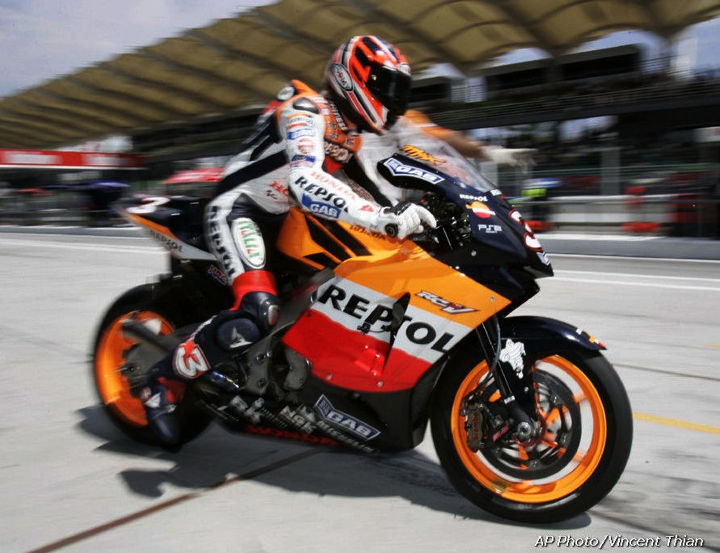 |
Synchro-sunlight photography. |
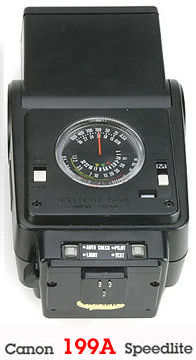 |
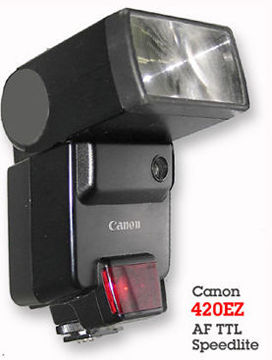 |
The above illustrates four major stages in the Canon's flash development prior to arrival of Canon EOS-1N & 540EZ AF TTL Speedlite era. The flash foot of each flash model mirrors the data communications in accordance with development of flash technologies of each stage in camera models. The last four models are capable of delivering A-TTL flash exposure control. and locking pin was added from 430EZ onwards. One way or another, Canon system backward compatibility permits many older flash to be used on newer bodies, except omission of certain added-on advance flash features only.
Suggestive Internal or External Link to these Canon Speedlite 160E | 300EZ | 300TL | 420EZ | 430 EZ | 480EG | 540EZ | other non-TTL Canon flash models
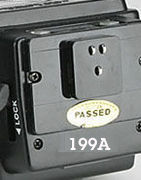 |
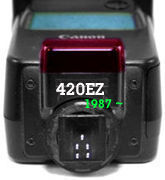 |
 |
Question: - Technically, since all connection between camera and a auto thrisyter are via the hot shoe connection and most likely the center main contact is about at the same location; so - Can older Canon flash unit(s) be used on the EOS-1N ? Possible. Perhaps only restrictive in Manual Mode only and at full flash output. What about the other way (EOS system flash onto older FD system SLRs ? Not encouraged. A good friend of mine, Philip Chong (by the way, I called him Captain Canon...) actually tried to figure out with Canon official warning whether has some truth in it (Canon dedicated Speedlites. uses 6 volts DC through their trigger circuits. applicable to most EOS cameras), he sacrificed his aged 420EX onto the New Canon F-1, the flash was, errr .. damaged. I think possibly the few other flash contacts were not covered or shielded from possible connection between camera/flash. Anyway, don't try to be outsmart them, I will not be responsible for any mishap on both of your camera or flash if spoilt for this... hehe..
|
Model |
Maximum flash sync shutter speed |
Availability
/ unavailability of |
Date of release |
|||
|
1/90 |
1/125 |
1/200 |
1/250 |
|||
|
Canon EOS 650 |
|
|
|
|
|
1987.03 |
|
Canon EOS 620 |
|
|
|
|
|
1987.05 |
|
Canon EOS 750 |
|
|
|
|
|
1988.10 |
|
Canon EOS 850 |
|
|
|
|
|
1988.10 |
|
Canon EOS 630 |
|
|
|
|
|
1989.04 |
|
Canon EOS-1 |
|
|
|
|
|
1989.09 |
|
Canon EOS RT |
|
|
|
|
|
1989.10 |
|
Canon EOS 10 |
|
|
|
|
X (EOS-10S QD info link) |
1990.03 |
|
Canon EOS 700 |
|
|
|
|
X (EOS-700QD info link) |
1990.03 |
|
Canon EOS 1000 |
|
|
|
|
X (EOS-1000F info link) |
1990.10 |
|
Canon EOS 100 |
|
|
|
|
X (EOS-100 / Elan QD info link) |
1991.10 |
|
Canon EOS 1000s |
|
|
|
|
X (EOS-1000FN /Rebel S II QD info link) |
1992.04 |
|
Canon EOS 5 |
|
|
|
|
X (EOS-5/A2E QD info link) |
1992.11 |
|
Canon EOS Kiss |
|
|
|
|
X (EOS-500 info link) |
1993.10 |
|
Canon EOS 1N |
|
|
|
|
X |
1994.10 |
|
Canon EOS 1N RS/RT |
|
|
|
|
X |
1995.03 |
NOTE;- For most Canon xxxEZ Compatibility with Pre-EOS Camera models Canon the Canon 540EZ be used on Pre-EOS cameras ? In a word, TTL automatic flash operation is possible with the T90, but with other cameras the flash must be used manually using guide number calculations. Supplementary explanations are provided below. (a) With AE SLRs equipped with a JCC contact on the accessory shoe, the synchronous shutter speed is automatically set upon completion of flash charging. (b) With the T90, which is equipped with TTL automatic flash control circuitry, both A-TTL and TTL automatic flash exposure are possible. However, since data communications between the camera and flash differ from the EOS system, operation is restricted as follows:
• Auto zoom, f/No display and coupling range display are not provided on the 540 EZ.
• Flash exposure compensation from the flash unit side can be set on the 540EZ, but it does not function.
• Second-curtain synchronization can be set but does not function,
When attached to the T80 and previous cameras which are not equipped with a TTL automatic flash control function, the 540EZ fires at full power because the camera does not send a stop signal to the flash unit. Manually set the aperture according to the value calculated from the "Guide number divided by Shooting distance" formula. In manual firing mode, the 540EZ operates at the output level indicated in the display. Note:- some EZ models such as Canon 160E, 200E etc. which have no manual modes other then TTL, it will burst the flash at maximum flash output when uses it with a Canon compatible camera that has no TTL flash control.
For Canon 540EZ when uses EOS cameras other than the EOS-1N, CLICK HERE for the compatibility Chart (models confined to to EOS-1n Era).
Maximum flash sync shutter speed and availability/ unavailability of an out-of-coupling-range warning with A-TTL pre-flash for each EOS model
Possibly due to Canon's late entry into exploring potential of TTL flash exposure control, I know some of you often like to compare Canon flash system with other rivalries (esp. Nikon) in this area. Don't be. Canon flash has a long history in auto flash system, even the last pro series Canon model prior to arrival of EOS-1, the Canon New F-1 (1981) was still adopting conventional auto flash method much due to emphasis on providing multiple options on a few metering systems which has resulted in a lapse of a generation behind the main stream development in this area. Lesson has learnt and one of the main system design in the EOS concept back in 1987 was reverted back to adopt TTL OTF (Through the Lens, Off the Film Plane) flash metering (an original concept first pioneered by Olympus OM2N back in 1975), as various advantages as well as enormous potential offer with TTL metering will provide workable solution where conventional auto flash technique couldn't provide. Well, the first experimental Canon SLR camera which adopted this method was not the EOS, it was the pre-EOS era's FD-mount Canon T90 of 1986. In fact, many of the advance TTL flash system employed in the early and even some second generation EOS SLR cameras were already replicating T90 method into them (A-TTL , just for an example).
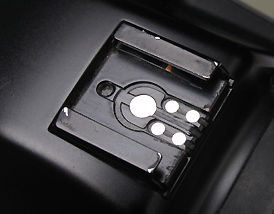 |
|
Due to interpretation of the word "pro-oriented" and assumption of what most professional want in a camera, non of the Canon EOS-1 series models have a built-in flash on the pentaprism. Well, I would think if ever the EOS-1(n) has interchangeable prism feature, an optional finder with a built-in flash would be nice (Nikon lacks imagination in this kind of application with their Nikon F5, even if they have that...hehe). This causes all EOS-1 series models require a hand mounted flash (Speedlite, in Canon's term for their lineup of flash units). The accessory shoe is the primary section where flash can be mounted and use; a supplementary connection is via a conventional PC-terminal at the side of the body for, bracket mounted flash, off camera cable connection or a mean to provide non-dedicated third party flash. Please note when the latter method is used, ONLY manual or auto flash is possible with this connection (i.e. via PC terminal). |
The EOS flash exposure control
system is based on the TTL automatic flash exposure control system employed in the
T90 SLR and 300TL flash unit released in 1985/6, but incorporates technological improvements
that have accompanied the evolution of the EOS system. Description of the evolution
of the EOS flash exposure control system have been discussed in quite a number of
web forums, where descriptions of the functions and features of the EOS Speedlites.
when used with various flash-related accessories are many as well (One very good
web site I came across recently on Canon Flash photography is PhotoNote.Org.). Anyway, the creation of this site
is not to challenge anyone, rather just aim to compile some of the info in orderly
as references. As I had finished the AF-Nikon F4, Nikon F5 and MF-Olympus Flash systems, so it is equally interesting to observe
the changes among the few major Camera system how the development of flash photography
evolved over the years. EOS TTL automatic flash exposure control system basic operation
and flash exposure Control is carried out in two steps. First, EOS camera determines
the appropriate flash control aperture value and shutter speed. Next, during exposure,
light reflected from the film is measured in real-time, and TTL automatic flash exposure
control is carried out based on the flash aperture value set.
 |
In a last minute of attempt for the official announcement by International Olympic Council decision on 2012 Olympic City. Soccer superstar Davic Beckham arrived to act as PR for London. |
Although many think that flash
photography is probably difficult when they hear mention of the EOS flash system,
operation is actually very similar to normal AE (ambient light) photography. In other
words, all the user has to do is to select Full Auto or P (program) mode if it is
desired to leave everything up to the camera, select shutter-priority AE mode if
the user wants to set the shutter speed, or select aperture-priority AE mode if the
user wants to set the aperture value. After that, all that is required is to make
sure the flash ready light is lit before taking each picture. However, use of flash
does introduce a few differences compared to normal AE photography, as described
below:
* Available shutter speeds are restricted
to the camera body's fastest flash synchronizing (X-sync) speed.
* Body metering characteristics differ
during flash exposure.
* When the camera is set to fully automatic
operation, the method used internally by the camera to determine the aperture and
shutter speed values differs from normal program AE operation.
The TTL flash control exposure level is controlled internally by the EOS camera body.
In basic terms, the flash operates according to commands sent from the camera. Regardless
of the situation, TTL automatic flash exposure level control is carried out internally
by the camera at the time of exposure based on the actual aperture setting by metering
the light reflected off the film in real-time. When the exposure reaches the correct
level as determined by the camera, the camera sends an "OFF' signal to the flash
unit to stop the flash output. When the flash output is cut off, the stored energy
still remaining in the flash unit is saved and combined with new energy from the
batteries for use in the next flash emission. Note: Flash exposure control
is based on the assumption that the flash is used to provide artificial illumination
in low-light situations or fill light in backlit situations. If flash is used in
bright, front-lit situations which could be properly exposed without flash, the result
will generally be overexposure.
| previous | NEXT |
1/4 MORE discussion .. ...-
Flash Photography:- Part 1 | 2 | 3 | 4 - Canon 540EZ site
Selective
Canon TTL Flash Models:-
160E | 200E | 300EZ | 300TL | 420EZ | 430
EZ
| 480EG | 540EZ | Macrolite | Other non-TTL Canon flash models |
Useful
Resources at Julian Loke site: - Instruction Manual(s (PDF) for Canon
420EX
| 580EX AF-TTL Speedlites.
Suggestive weblink:-
Canon Flash Resources at Photonotes.org or Bob Atkin Flash FAQ
section
| Questions, Issues
& Answers
| Canon
EOS-1 Series Message
Board
|
Canon
EF lens Board
| in
a shared environment
|
Free Trade Zone |
shared
environment
| Back | Index Page The Canon EOS-1N
Series Professional SLR camera
|
Back | Main Index Page The Canon EOS-1
Series Professional SLR camera
Background and Various Issues
| The Basic
Features &
various Setup
Manual &
Auto Focusing |
Metering Systems | Exposure Control | Viewfinder
Optical
System Flash Photography (with Speedlite 540EZ extension & Selective info on Canon TTL Flash Models:-160E | 200E
| 300EZ | 300TL
| 420EZ | 430 EZ | 480EG | MacroLites | Other non-TTL Canon flash model
Reliability Issues:- Body Chassis | Shutter Unit | Electronic Circuitry | Film Transport & film handling Secondary Functions:- Custom Function Part One | Part Two | System Accessories:- Film Back Options - instruction for Command Back E1 | Macro/Close Up Part one | Part two and Part III Flash for Macro-Photography | Power Sources -BP-E1 | PDB-E1 | Focusing Screens | Remote Control with Wireless Remote Set LC-3 | System compatibility
Variants of Canon EOS-1N:- Canon EOS-1N RS | Canon/Kodak Digital DCS-1, 3 -5 & 520/560 Series | Full Technical Specification | Main
Reference Map / Nomenclature
| Resource Centre:- Comparative Charts between EOS-1 &
EOS-1N / or with
its active Competition(s) (Nikon); Quick Operational Reference Card (278k Gif File);
Listings of 7-segment
digital numbers/letters
appeared on LCD display panel/viewfinders (HTML page); External Link:-Instruction Manual (3.3MB
PDF file applicable for both Canon
EOS-1N (RS). | Using EOS system for your photography | Bots & Nuts of EOS System - by Philip Chong |
The Eyes of EOS -
EF Lenses
A little OFF-TOPIC SOME Personal Thought
HOME - Photography in Malaysia |
Volunteered Maintainer(s) for the Canon EOS-1N Series Message Board: Philip Chong, Editor, Digital Camera Magazine; Vincent Thian, Photo Editor, Malaysian Bureau, Associated Press "AP", CYleow, Ex-photo Editor of local daily, The Star; Gary Rowan Higgins, Australia and other nice folks on the web.
Special Credit:- :Mr. Richard Yeow & Mr. Simon Wong from camera division of ![]() Marketing Malaysia, for their continual effort in
supporting development of this EOS/EF website. Others: All the nice people on earth who have contributed
their photos and pictures of personal works or product shots for the creation of
this site. Certain content and images appeared in this site were either scanned
from official marketing leaflets, brochures published by Nikon and/or contribution
from surfers who claimed originality of their own work for public publishing in this
website, where majority of the extracted information are used basing on educational
merits. The creator of this site will not be responsible for any discrepancies that
may arise from any possible dispute except rectifying them after verification from
respective source. Neither Nikon or its associates has granted any permission(s)
in using their public information nor has any interest in the creation of this site.
"Canon", "EOS",
"EF" "RT", "EOS-1n RS", "Booster
", "Macrolite", "fluorite", "Image Stabilizer"
& other applicable technical/business terms are registered trade name(s) of Canon
Inc., Japan. Site made with an Apple G5 IMac.
Marketing Malaysia, for their continual effort in
supporting development of this EOS/EF website. Others: All the nice people on earth who have contributed
their photos and pictures of personal works or product shots for the creation of
this site. Certain content and images appeared in this site were either scanned
from official marketing leaflets, brochures published by Nikon and/or contribution
from surfers who claimed originality of their own work for public publishing in this
website, where majority of the extracted information are used basing on educational
merits. The creator of this site will not be responsible for any discrepancies that
may arise from any possible dispute except rectifying them after verification from
respective source. Neither Nikon or its associates has granted any permission(s)
in using their public information nor has any interest in the creation of this site.
"Canon", "EOS",
"EF" "RT", "EOS-1n RS", "Booster
", "Macrolite", "fluorite", "Image Stabilizer"
& other applicable technical/business terms are registered trade name(s) of Canon
Inc., Japan. Site made with an Apple G5 IMac.
